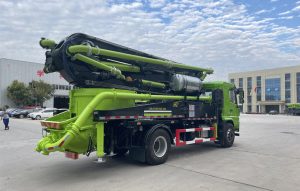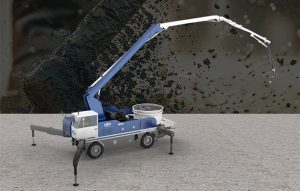The construction industry frequently encounters challenging weather conditions that test the limits of equipment performance, particularly when utilizing portable concrete pump systems mounted on boom truck for sale units. These versatile machines combine the precise placement capabilities of boom pumps with the mobility of truck-mounted systems, making them indispensable for projects requiring concrete delivery in confined or remote locations. However, extreme weather – whether scorching heat, freezing temperatures, heavy rainfall, or high winds – demands specialized operational strategies to maintain safety, equipment integrity, and concrete quality. This comprehensive guide examines proven techniques for optimizing portable concrete pump performance on boom truck for sale equipment under various severe weather scenarios, drawing from engineering best practices and field-tested solutions.

Managing High Temperature Operations
When operating a portable concrete pump in boom truck for sale configurations under extreme heat (above 95°F/35°C), contractors must address three critical challenges: concrete mix stability, hydraulic system overheating, and operator safety. The elevated ambient temperatures accelerate concrete setting time while increasing water evaporation rates from the mixture. To counteract this, batch plants should modify mixes with set retarders (typically hydroxycarboxylic acid derivatives at 0.1-0.3% by cement weight) and consider using mid-range water reducers that maintain workability without sacrificing strength. The boom truck for sale units themselves require pre-cooling of hydraulic reservoirs through auxiliary heat exchangers, with monitoring systems tracking oil temperature to prevent viscosity breakdown (maintain below 180°F/82°C). Operators should schedule pumping operations for early morning hours when possible, utilizing reflective insulation blankets on exposed pipeline sections to reduce solar heating. The portable concrete pump boom sections benefit from periodic misting during breaks to prevent metal surface temperatures from exceeding 150°F (65°C), which can cause premature wear on polyurethane seals and gaskets.
Winter Weather Concrete Pumping Protocols
Freezing conditions present unique difficulties for portable concrete pump systems deployed via boom truck for sale equipment. Subzero temperatures risk concrete freezing within the delivery system while threatening hydraulic fluid performance and structural steel integrity. For temperatures between 20°F to 32°F (-6°C to 0°C), heated enclosures around the portable concrete pump hopper and valve section maintain optimal concrete temperature, with electric blanket systems (minimum 150W/sq ft) installed along the boom pipeline. Below 20°F (-6°C), contractors must implement multi-layer protection: insulated forms with thermal blankets for placed concrete, glycol-based hydraulic fluid with -40°F (-40°C) pour point ratings in the boom truck for sale power pack, and windbreak barriers around the work area. The pumping process itself requires continuous operation once started – pauses exceeding 15 minutes risk concrete setting in the lines, necessitating emergency flushing with heated wash water (minimum 140°F/60°C) containing 5% calcium chloride solution. Pipeline heating cables (self-regulating 30W/ft) prove invaluable for maintaining concrete temperature during extended placements in cold weather.
Heavy Rain and Flood Condition Strategies
The mobility advantages of boom truck for sale mounted portable concrete pump systems often see them deployed in stormwater management projects or emergency repairs during wet weather. Operating in sustained rainfall requires waterproofing measures for both equipment and concrete quality. The pump’s electrical systems – particularly control panels and sensors on modern portable concrete pump units – need IP65-rated enclosures with silica gel desiccant packs to prevent moisture intrusion. Concrete mixes should incorporate hydrophobic admixtures (like stearate compounds) at 1-2% by cement weight to reduce surface water absorption, with slump maintained at the lower end of specification (75-100mm) to minimize segregation. The boom truck for sale chassis requires special attention to braking systems – weekly brake fluid moisture testing (keep below 3% water content) prevents vapor lock during wet operations. For flood zone work, extended outrigger pads (minimum 24″×24″) distribute loads on saturated ground, while ultrasonic level sensors can monitor rising water around equipment positions in real-time.
High Wind and Dust Storm Adaptations
Wind speeds exceeding 25 mph (40 km/h) create stability concerns for portable concrete pump booms while exacerbating concrete moisture loss. The boom truck for sale outrigger system should be deployed with 20% greater extension than normal to lower the center of gravity, with anemometer readings integrated into the pump’s safety interlock system (automatic shutdown at 35 mph/56 km/h). Boom pipeline configurations should minimize wind-catching profiles – using shorter, larger diameter sections rather than multiple small pipes. In dusty environments like desert projects, the portable concrete pump hydraulic cylinders benefit from wiper seal upgrades (polyurethane with secondary scrapers) and pressurized filter housings on reservoir breathers. Concrete mixes may require viscosity-modifying admixtures (0.1-0.4% cellulose ether) to combat rapid surface drying, with fog spray systems maintaining humidity around the placement area. Operators should position the boom truck for sale cab upwind of pumping operations when possible, utilizing HEPA filtration on HVAC systems during prolonged dust exposure.
Altitude and Thin Air Considerations
High-altitude projects above 8,000 feet (2,400 meters) challenge portable concrete pump performance through reduced atmospheric pressure and oxygen levels. The boom truck for sale diesel engine requires turbocharger adjustments (wastegate modifications) to maintain power output, while hydraulic systems need pressure-compensating pumps to account for lower boiling points of fluids. Concrete mixes demonstrate accelerated setting times at altitude – retarder dosage increases of 25-50% over sea level recommendations help maintain workability. The portable concrete pump pipeline pressure losses become more pronounced, necessitating shorter pumping distances or increased line sizes (transition to 5″ pipe instead of 4″ above 10,000 feet). Operator fatigue management becomes critical, with oxygen enrichment systems recommended for cabs operating above 12,000 feet (3,600 meters).
Equipment Maintenance for Extreme Weather Resilience
The boom truck for sale platform and portable concrete pump system require weather-specific maintenance routines to ensure reliability. In marine environments, bimonthly ultrasonic thickness testing of structural steel identifies salt-induced corrosion early, while zinc-rich epoxy coatings (minimum 8 mil DFT) protect critical components. Desert operations demand daily cleaning of cooling system fins and weekly greasing of all boom joints (high-temperature lithium complex grease). For arctic conditions, cold-start procedures should include hydraulic oil pre-heating (maintain 50°F/10°C minimum) and battery blanket operation below freezing. All extreme weather scenarios benefit from real-time equipment health monitoring systems – vibration analysis for early bearing failure detection in dusty conditions, or infrared thermography for identifying electrical faults in humid environments.
Emergency Protocols and Contingency Planning
Despite precautions, extreme weather may overwhelm standard operating procedures for portable concrete pump and boom truck for sale systems. Lightning proximity alarms should trigger immediate shutdown (within 5 miles/8 km), with all personnel retreating to grounded vehicles. Flash flood warnings necessitate pre-planned evacuation routes to higher ground for equipment. Each jobsite should maintain weather-specific emergency kits – including concrete line flushing equipment for sudden freezes, or electrolyte replacement fluids for heat stroke prevention. Modern telematics systems allow remote monitoring of parked boom truck for sale units during severe weather, with geofence alerts for unexpected movement during high winds or flooding.
The successful deployment of portable concrete pump systems on boom truck for sale chassis in extreme environments ultimately depends on proactive planning, weather-adapted concrete technology, and equipment modifications that address specific climate challenges. By implementing these specialized strategies, contractors can maintain productivity while protecting both personnel and investments against nature’s most demanding conditions.

Leave a Reply